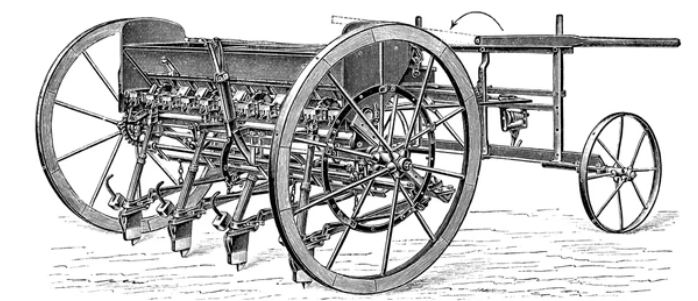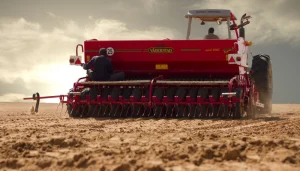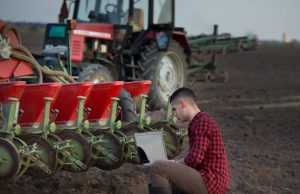The seed drill, a pivotal invention in agricultural history, was created by Jethro Tull in the year 1701.
While the modern seed drill we recognize today is often attributed to Jethro Tull’s invention in 1701, the concept of a seed drill has a much longer history! Here’s a breakdown:
-
2nd Century BCE:
The earliest evidence of a multi-tube iron seed drill comes from China. This design played a significant role in China’s efficient food production for centuries.
-
1400 BCE:
Babylonians used primitive seed drills, though they never gained widespread adoption or reached Europe.
-
16th Century:
The first known European seed drill was patented in Venice by Camillo Torello. Around the same time, India also utilized seed drills extensively.
-
1701;
Jethro Tull developed and refined the seed drill in England during the Agricultural Revolution. His design included a hopper, cylinder, and funnel for precise seed placement and depth control. This marked a significant improvement over earlier models.
who invented the seed drill?
The seed drill was invented by Jethro Tull, an English agricultural pioneer and inventor. Jethro Tull developed the seed drill in 1701, marking a significant advancement in agricultural technology. His invention revolutionized the process of sowing seeds by introducing a more precise and efficient method, ultimately contributing to increased crop yields and improved farming practices.
about the life of Jethro Tull’s
There are two notable figures named Jethro Tull, so I need some context to understand which one you’d like to know about:
-
Jethro Tull (agriculturist):
He was an Englishman born in 1674 who revolutionized agriculture with his inventions, particularly the horse-drawn seed drill and hoe. He faced initial resistance but his methods eventually took root and formed the basis for modern British farming practices. He died in 1741.
-
Jethro Tull (band):
They’re a British progressive rock band formed in 1967. Known for their eclectic blend of rock, blues, jazz, folk, and classical influences, they achieved great success with hits like “Aqualung” and “Locomotive Breath.” Led by Ian Anderson on flute and vocals, the band disbanded in 2011 but Anderson revived the name for new albums in the 2020s.
before his invention
The invention of the seed drill isn’t solely attributed to one person, but rather has a fascinating history with contributions from various cultures and minds across centuries!
One of the earliest known seed drills emerged in 2nd century BCE China, featuring a multi-tube iron design that played a major role in their efficient food production for centuries. While this design didn’t reach Europe, it showcases the long-standing human ingenuity in seeking precise sowing methods.
Fast forward to the 16th century, and Europe sees the first patent for a seed drill by Camillo Torello in Venice. Around the same time, India also saw widespread use of seed drills, demonstrating the independent development of this technology in different parts of the world.
However, the name most often associated with the seed drill in the Western world is Jethro Tull, an Englishman who in 1701 refined and popularized the concept with his design. His seed drill featured a hopper, cylinder, and funnel to precisely control seed placement and depth, marking a significant improvement over earlier models.
So, while Jethro Tull’s 1701 invention and its impact on European agriculture are noteworthy, remember, the story of the seed drill is much richer, with contributions from various cultures and inventors throughout history. It’s a testament to the shared human desire for innovation and efficiency in feeding ourselves!
His invention
Since you didn’t clarify which Jethro Tull you’re curious about, I’ll assume you’re interested in the inventions of the agricultural pioneer, Jethro Tull, who lived from 1674 to 1741. Let’s dive into his two most impactful inventions:
1. Seed drill (1701):
- Before Tull, seeds were scattered by hand, leading to uneven distribution and wasted seeds.
- Tull’s seed drill precisely sowed seeds in neat rows at the correct depth and spacing.
- The drill used a hopper to store seeds, a rotating cylinder to regulate their flow, and a funnel to direct them into furrows created by a plow.
- This method ensured efficient seed usage, improved growth, and increased crop yields.
- It sparked the Agricultural Revolution by allowing larger farms and reducing labor costs.
- Although not the first seed drill ever invented, Tull’s design was practical and user-friendly, leading to its widespread adoption.
2. Horse-drawn hoe (1730s):
- Traditionally, weeding was done by hand, requiring immense time and effort.
- Tull’s horse-drawn hoe cultivated the soil between crop rows, eliminating weeds without harming crops.
- This innovation boosted yield further by improving soil aeration and nutrient availability.
- It also saved farmers significant labor, making their work more efficient and profitable.
Bonus inventions:
- Tull also improved upon existing plows and developed other agricultural tools to refine his “drill husbandry” system.
- His book, “The New Horse-Houghing Husbandry,” outlined his theories and practices, influencing agricultural practices for centuries.
Jethro Tull’s inventions revolutionized agriculture and laid the foundation for modern farming practices. His seed drill and horse-drawn hoe significantly improved efficiency, productivity, and profits, ensuring a more abundant food supply for future generations

Public Reviews of Jethro Tull’s Seed Drill (1701-1720s):
The Skeptics:
- Old George, Farmhand: “Blasted contraption! Horses won’t pull it straight, seeds don’t scatter right, and the whole thing seems built by a drunken clockmaker! Give me my good old pouch and elbow any day!”
- Lady Mildred, Landowner: “Tull’s drill? A whimsical notion, my dear. My tenants wouldn’t know what to do with it, and their backs are bad enough from bending all day. Stick to what works, I say.”
- Farmer Thomas: “Hmph, fancy gizmo for fancy folk. My father sowed by hand, his father before him, and their fathers before that. We get good yields, and my son can learn the trick easily. No need for newfangled contraptions here.”
The Cautious:
- Mrs. Agnes, Farmwife: “Well, it looks complicated, but the Squire seems mighty taken with it. Says it saves seeds and grows heartier crops. Maybe worth a try on a small plot, then see if it lives up to the hype.”
- Young William, Apprentice: “Master Tull swears by it! Says it cuts planting time in half, and I wouldn’t mind a break from my aching back. But it’s a hefty price, and if it breaks, who knows how to fix it?”
- Farmer John: “Heard tell of Tull’s contraption. Seems clever, but I’m waiting for the neighbors to try it first. If theirs does wonders, maybe I’ll give it a go with next year’s barley.”
The Early Adopters:
- Farmer Edward: “By the rood, it’s a marvel! Planted my wheat in half the time, in straight rows like soldiers, and not a wasted seed. Already seeing sprouts pushing through, thicker than ever before!”
- Miss Agatha, Innkeeper: “Tull’s drill? You won’t catch me near it! Those horses kick up a devil of dust and the noise! But the farmers… they’re talking yields twice the usual, grain the size of your fist! Seems he might be onto something after all.”
- Young Tom, Farmhand: “Used to bend ’til my knees sang planting time. Now, this drill does the work, and I get to ride beside the horses! Easier, faster, and the Squire’s grinning wider than a pumpkin. Tull’s a genius, I tell you!”
Remember, these are just snapshots of how public opinion might have looked in the years following Tull’s invention. There would have been a range of reactions, from outright dismissal to cautious interest and eventually, for some, excited adoption.
It’s worth noting that Tull’s seed drill faced initial resistance and took some time to gain widespread acceptance. However, its benefits of improved efficiency, increased yields, and reduced labor eventually won over many farmers. Today, it’s recognized as a landmark invention in the history of agriculture, paving the way for modern mechanized farming practices
benefits of this invention
The benefits of Jethro Tull’s seed drill were numerous and far-reaching, revolutionizing agriculture and paving the way for modern farming practices. Here are some of the key advantages:
Increased Crop Yields:
-
Precise seed placement: Unlike the haphazard scattering of seeds by hand, the drill ensured seeds were planted at the optimal depth and spacing, leading to better germination, growth, and ultimately, higher yields.
-
Reduced seed waste: By eliminating over-sowing and bird predation, the drill significantly reduced the amount of seed needed, saving farmers money and resources.
Improved Efficiency and Labor Savings:
-
Faster planting: Compared to hand-sowing, the drill dramatically sped up the planting process, allowing farmers to cover more ground in less time.
-
Reduced weeding needs: The evenly spaced rows enabled the use of horse-drawn hoes, replacing the laborious task of hand weeding, further saving time and manpower.
Enhanced Soil Health and Sustainability:
-
More controlled tillage: The drill minimized soil disturbance compared to traditional plowing, helping to preserve soil structure and organic matter, crucial for long-term soil health.
-
Reduced erosion: By leaving crop residues between rows, the drill helped prevent soil erosion from wind and water, promoting sustainable land management.
Overall Impact:
-
Increased food production: The combination of higher yields, efficiency gains, and improved soil health led to a significant boost in overall food production, contributing to feeding a growing population.
-
Economic prosperity: The success of the seed drill spurred advancements in other agricultural technologies and practices, contributing to the economic prosperity of farming communities.
-
Foundation for modern agriculture: Jethro Tull’s invention laid the foundation for the mechanized and efficient farming practices we see today, continuing to influence agricultural development worldwide.

conclusion
In conclusion, Jethro Tull’s seed drill stands as a monumental invention in the history of agriculture. Its impact resonates far beyond its innovative design, fundamentally altering farming practices and contributing to a transformation of food production.
Key takeaways:
- Precise seed placement and spacing: This revolutionary aspect ensured optimal germination, growth, and significantly higher yields.
- Increased efficiency and labor savings: The drill vastly sped up planting and eased weeding, saving time and manpower.
- Enhanced soil health and sustainability: Controlled tillage preserved soil structure and reduced erosion, promoting long-term sustainability.
- Overall impact: The invention led to increased food production, and economic prosperity for farmers, and laid the foundation for modern mechanized agriculture.
Jethro Tull’s seed drill transcended its mechanical ingenuity, becoming a symbol of progress and efficiency. Its influence continues to shape the way we approach agriculture, ensuring food security and contributing to a future where sustainable practices flourish.
FAQs :
What was Jethro Tull’s seed drill?
Jethro Tull’s seed drill was a horse-drawn machine invented in 1701 that revolutionized agriculture by precisely sowing seeds at the correct depth and spacing. This eliminated the need for hand-sowing, which was wasteful and inefficient.
How did the seed drill work?
The seed drill had a hopper that held the seeds, a cylinder that dispensed them, and a funnel that directed them into furrows created by a plow. The depth of the furrows could be adjusted, and the spacing of the seeds could be controlled by the speed of the drill.
What were the benefits of the seed drill?
- Increased yields: The seed drill ensured that seeds were planted at the optimal depth and spacing, which led to better germination and growth, resulting in higher crop yields.
- Reduced labor: The seed drill significantly reduced the amount of time and labor required for planting, freeing up farmers to do other tasks.
- Improved soil health: The seed drill minimized soil disturbance compared to traditional plowing, which helped to preserve soil structure and organic matter.
- Reduced seed waste: The seed drill eliminated the need for hand-sowing, which often resulted in wasted seeds.
What was the impact of the seed drill?
The seed drill had a profound impact on agriculture, leading to increased food production, economic prosperity for farmers, and the development of new farming practices. It is considered one of the most important inventions in the history of agriculture.
Was Jethro Tull the first to invent a seed drill?
No, while Jethro Tull’s design is often credited with revolutionizing the seed drill, the concept existed much earlier. There is evidence of seed drills being used in China as early as the 2nd century BCE, and in Babylonia around 1400 BCE. However, Tull’s design was more practical and user-friendly than earlier models, which led to its widespread adoption.





